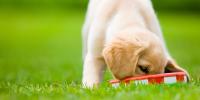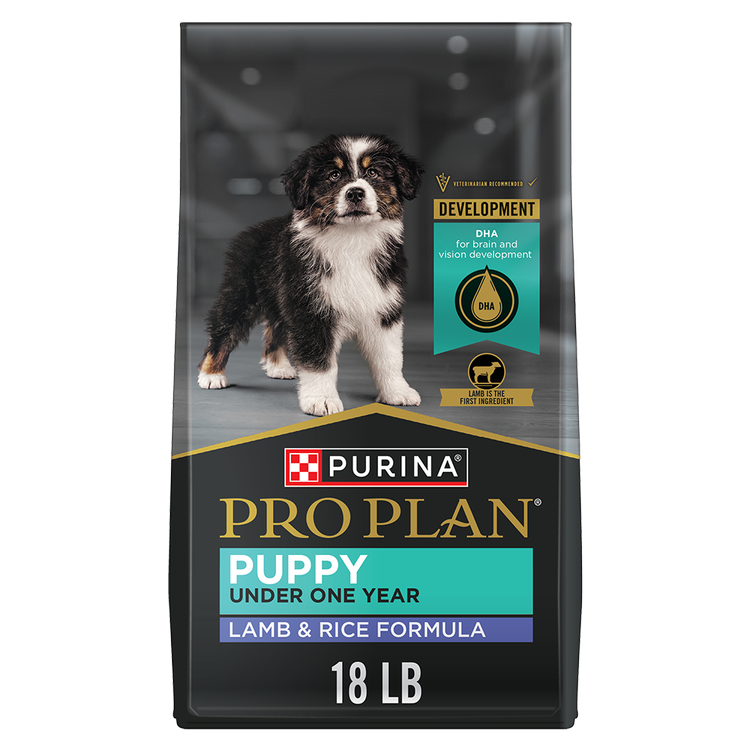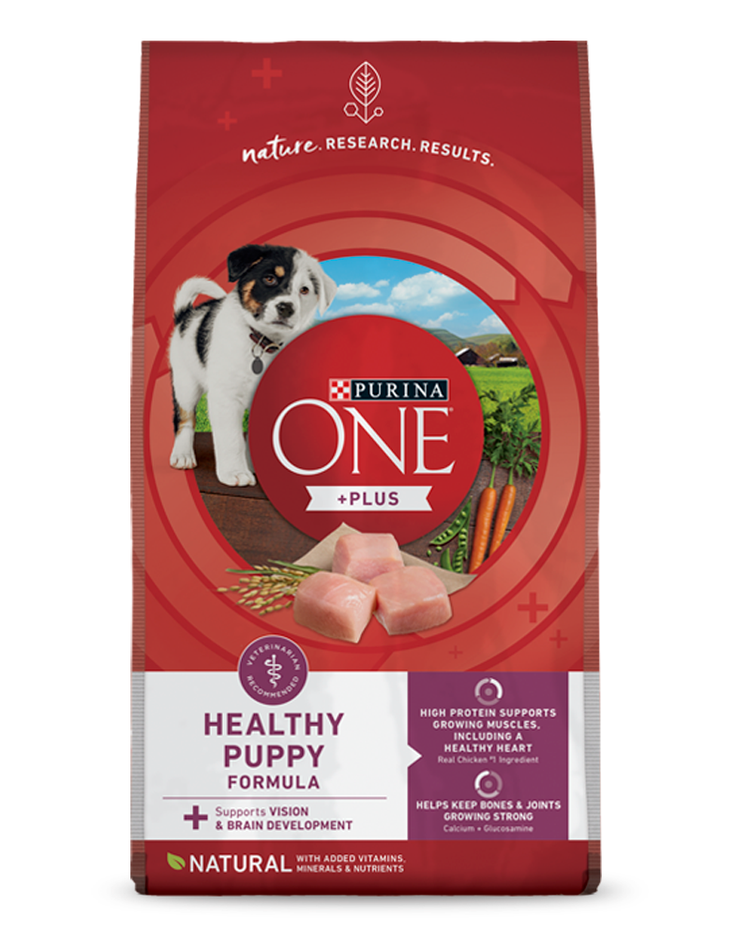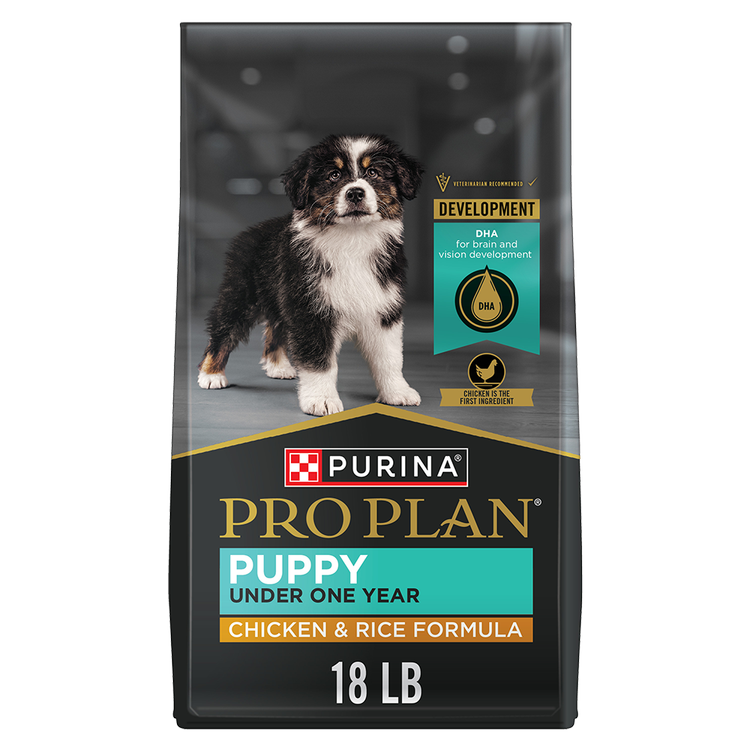Whether you’re shopping for puppy food in store or online, the sheer number of options can be overwhelming.
With so many options to choose from, how do you know what to feed your puppy? Good nutrition is important for growing puppies. A quality food now can help ensure your puppy grows into a happy, healthy dog.
Our experts are here to help you navigate the pet food aisle to find the right food for your puppy.
Importance of Feeding Puppy Food
Simply put, puppies need puppy food. Puppies grow fast and need a high-calorie, nutrient-dense food to support their growth and development.
Expect to feed puppy food for about a year, or until your pup reaches full maturity. Our experts and your veterinarian can help you better understand when to stop feeding puppy food.
What to Feed Your Puppy
Although puppies need puppy food, it’s not that simple when there are so many to choose from. Puppy food comes in a variety of options, from dry kibble to canned wet food. Plus, there are formulas for large and small breeds and other specific health needs.
Regardless of the specific type of food you choose, there are essential nutrients all puppy food should contain.
Key nutrients to look for in a high-quality puppy food include:
- High-quality sources of protein to support a growing body
- Minerals like calcium and phosphorous to support growing bones and teeth
- High-quality fats to support growth and energy
- Antioxidants to support your puppy’s developing immune system
- DHA, an omega-3 fatty acid, to support brain and vision development
If your puppy’s food contains these essential nutrients, you can feel confident he’s getting the nutrition he needs to grow up healthy and strong.
Dry vs. Wet Puppy Food
Many puppy foods are available in dry or wet varieties. Both are a healthy and tasty option. Just make sure they’re both complete and balanced. Some wet foods are “all meat,” which won’t satisfy your puppy’s nutritional requirements.
If you’re trying to decide between dry and wet food, there are a few different factors to consider. Most puppy owners find dry food more convenient since it doesn’t spoil as easily.
You can feed either wet or dry food exclusively or a combination of the two. Regardless of which option you choose, ensure you aren’t exceeding the total recommended daily calories based on your puppy’s size. Our puppy feeding chart for dry food can help you determine how much food to feed your pup.
It’s important to note, however, that this chart doesn’t account for wet food.
“If you decide to incorporate both wet and dry food into your puppy’s feeding program, it is critical to understand that the caloric contribution of both should not exceed your puppy’s daily caloric or energy requirements,” says Purina Nutritionist Allison Millican, PhD.
“The caloric content is reported on the packaging, and you should use these values to understand how much wet product will replace the dry and vice versa,” she says. “For example, one thirteen-ounce can of wet food may contain four hundred and seventy-five kilocalories and replace approximately one cup of dry puppy formula. In this scenario, you could substitute a thirteen-ounce can of wet food for one cup of the daily dry food recommendation.”
“Remember,” she adds, “as your puppy grows, his body condition may change rapidly, so it is important to adjust as necessary to maintain his ideal body weight. You can find more feeding and calorie information on the brand’s website or consult your veterinarian to assist you in developing a feeding plan specific to your puppy’s needs.”
Large vs. Small Breed Puppy Formulas
Dry or wet isn’t the only thing to consider when choosing a puppy food. You also need to factor in your puppy’s breed size.
Large breed puppies have a higher risk of developing joint problems as adults. Feeding a large breed-specific puppy food can help support joint health and mobility into adulthood.
Small breed puppies have smaller mouths, so they may prefer the smaller kibble found in small breed-specific puppy formulas. “Small breed puppies also have a higher metabolism and therefore require more energy and a more nutrient dense diet,” says Purina Nutritionist, Karina Carbo-Johnson, MS.
How & When to Feed Puppies
Choose a quiet place for your puppy’s food and water bowls away from distractions and temptations like food prep areas and dining tables.
Give your puppy three equal-sized meals each day. Establish a feeding routine or schedule by feeding him the same amount of food at the same times each day, which can make housetraining easier.
Avoid overfeeding your puppy, as this can lead to excessive weight gain and other health problems. This includes treats, which should make up no more than 10 percent of his daily caloric intake.
When it comes to what to feed a puppy, Purina has a number of complete and balanced puppy food formulas to choose from. Explore our puppy food formulas to find one to help your pup grow up healthy and happy.
For more puppy nutrition tips from our experts, visit our Pet Expertise page.

How Much Food Is Right for Your Pet?
Get a personalized feeding guide for your dog or cat from Purina’s nutrition experts.








